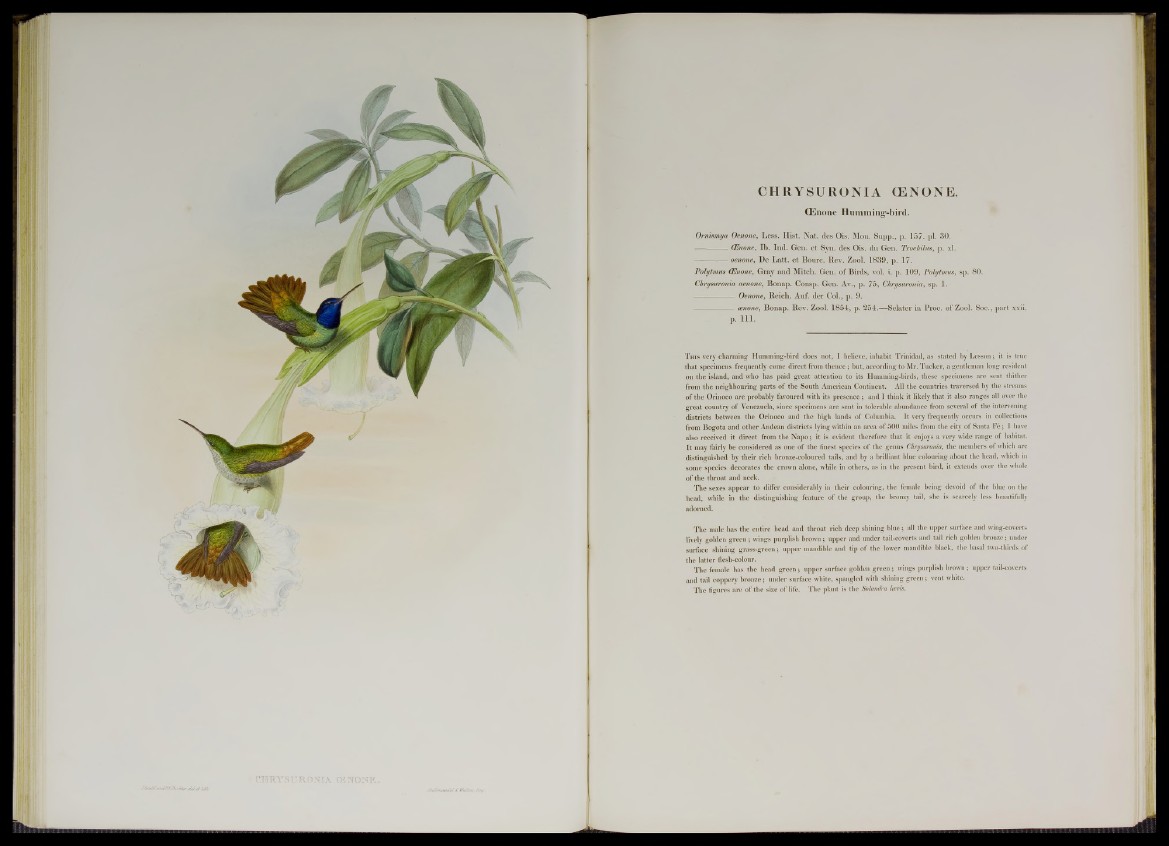
w
CHRYSURONIA CENONE.
CEnone Humming-bird.
Omismya Oenone, Less. Hist. Nat. des Ois. Mou. Supp., p. 157. pi. 30.
— (E/none, lb . In d . Gen. e t Syn. des Ois. du Gen. Ti'ochilus, p. xl.
——\oenone, De L a tt. e t Bourc. Rev. Zool. 1839, p. 17.
Polytmus (Enone, Gray and Mitch. Gen. o f Birds, vol. i. p. 109, Polytmus, sp. 80.
Chrysuronia aenone, Bonap. Consp. Gen. Av., p. 75, Chrysuronia, sp. 1.
— Oenone, Reich. Auf. der Col., p. 9.
-----------------oenone, Bonap. Rev. Zool. 1854, p. 254.— Sclater in Proc. o f Zool. Soc., part xxii.
p. 111.
T his very charming Humming-bird does not, I believe, inhabit Trinidad, as stated by Lesson; it is true
that specimens frequently come direct from thence; but, according to Mr. Tucker, a gentleman long resident
on the island, and who has paid great attention to its Humming-birds, these specimens are sent thither
from the neighbouring parts of the South American Continent. All the countries traversed by the streams
of the Orinoco are probably favoured with its presence ; and I think it likely that it also ranges all over the
great country of Venezuela, since specimens are sent in tolerable abundance from several of the intervening
districts between the Orinoco and the high lands of Columbia. It very frequently occurs in collections
from Bogota and other Andean districts lying within an area of 500 miles from the city of Santa F e ; I have
also received it direct from the Napo; it is evident therefore that it enjoys a very wide range of habitat.
It may fairly be considered as one of the finest species of the genus Chrysuronia, the members of which are
distinguished by their rich bronze-coloured tails, and by a brilliant blue colouring about the head, which in
some species decorates the crown alone, while in others, as in the present bird, it extends over the whole
of the throat and neck.
The sexes appear to differ considerably in their colouring, the female being devoid of the blue on the
head, while in the distinguishing feature of the group, the bronzy tail, she is scarcely less beautifully
adorned.
The male has the entire head and throat rich deep shining blue; all the upper surface and wing-coverts
lively golden green; wings purplish brown; upper and under tail-coverts and tail rich golden bronze; under
surface shining grass-green; upper mandible and tip of the lower mandible black, the basal two-thirds of
the latter flesh-colour.
The female has the head green ; upper surface golden green ; wings purplish brown ; upper tail-coverts
and tail coppery bronze; under surface white, spangled with shining green; vent white.
The figures are of the size of life. The plant is the Solandra Itevis.